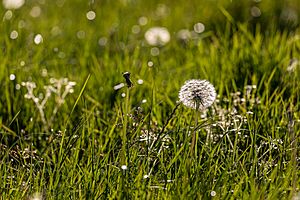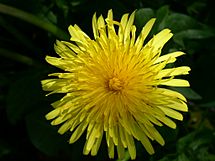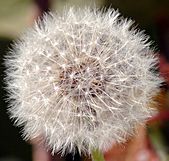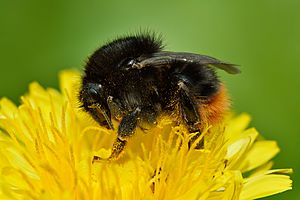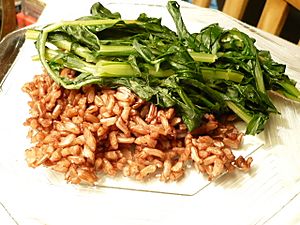Common dandelion facts for kids
Quick facts for kids Common dandelion |
|
|---|---|
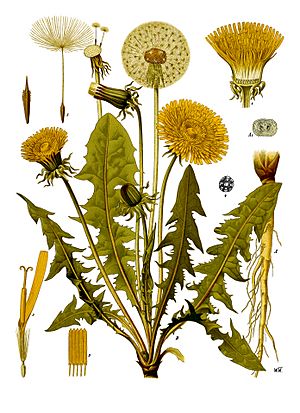 |
|
| Common dandelion | |
| Conservation status | |
| Scientific classification | |
| Genus: |
Taraxacum
|
| Species: |
officinale
|
| Synonyms | |
|
|
Taraxacum officinale, the dandelion or common dandelion, is a flowering herbaceous perennial plant of the dandelion genus in the family Asteraceae (syn. Compositae). The common dandelion is well known for its yellow flower heads that turn into round balls of many silver-tufted fruits that disperse in the wind. These balls are usually called "clocks" in both British and American English. The name "blowball" is also used.
The common dandelion grows in temperate regions of the world in areas with moist soils. It is most often considered a weed, especially in lawns and along roadsides, but the leaves, flowers, and roots are sometimes used in herbal medicine and as food.
Contents
Description
Taraxacum officinale grows from (generally unbranched) taproots and produces several hollow, leafless flower stems that are typically 5–40 centimetres (2–15+3⁄4 inches) tall, but sometimes up to 70 cm (28 in) tall. The stems can be tinted purplish, they are upright or lax, and produce flower heads that are held as tall or taller than the foliage. The foliage may be upright-growing or horizontally spreading; the leaves have petioles that are either unwinged or narrowly winged. The stems can be glabrous or sparsely covered with short hairs. Plants have milky latex and the leaves are all basal; each flowering stem lacks bracts and has one single flower head. The yellow flower heads lack receptacle bracts and all the flowers, which are called florets, are ligulate and bisexual. In many lineages, fruits are mostly produced by apomixis, notwithstanding the flowers are visited by many types of insects.
The leaves are 5–45 cm (2–17+3⁄4 in) long and 1–10 cm (1⁄2–4 in) wide, and are oblanceolate, oblong, or obovate in shape, with the bases gradually narrowing to the petiole. The leaf margins are typically shallowly lobed to deeply lobed and often lacerate or toothed with sharp or dull teeth.
The calyculi (the cuplike bracts that hold the florets) are composed of 12 to 18 segments: each segment is reflexed and sometimes glaucous. The lanceolate shaped bractlets are in two series, with the apices acuminate in shape. The 14–25 millimetres (1⁄2–1 in) wide involucres are green to dark green or brownish-green, with the tips dark gray or purplish. The florets number 40 to over 100 per head, having corollas that are yellow or orange-yellow in color.
The fruits, called cypselae, range in color from olive-green or olive-brown to straw-colored to grayish, they are oblanceoloid in shape and 2–3 mm (1⁄16–1⁄8 in) long with slender beaks. The fruits have 4 to 12 ribs that have sharp edges. The silky pappi, which form the parachutes, are white to silver-white in color and around 6 mm wide. Plants typically have 24 or 40 pairs of chromosomes, while some have 16 or 32 pairs.
Chemistry
| Taraxalisin | |
|---|---|
| Identifiers | |
| EC no. | ? |
| CAS no. | 217442-60-9 |
Taraxalisin is a serine proteinase found in the latex of dandelion roots. Rudenskaya et al. (1998) found that taraxalisin hydrolyzes a chromogenic peptide substrate Glp-Ala-Ala-Leu-pNA optimally at pH 8.0. Maximal activity of the proteinase in the roots is attained in April, at the beginning of plant development after the winter period.
Taxonomy
Carl Linnaeus named the species Leontodon taraxacum in 1753. The current genus name Taraxacum derives possibly from the Arabic Tharakhchakon, or from the Greek Tarraxos. The specific name officinalis refers to its value as a medicinal herb, and is derived from the word opificina, later officina, meaning a workshop or pharmacy.
The taxonomy of the genus Taraxacum is complicated by apomictic and polyploid lineages, and the taxonomy and nomenclatural situation of T. officinale is not yet fully resolved. The taxonomy of this genus has been complicated by the recognition of numerous species, subspecies and microspecies. For example, Rothmaler's flora of Germany recognizes roughly 70 microspecies.
T. officinale has a fossil record that goes back to glacial and interglacial times in Europe.
North American dandelions
The plants introduced to North America are triploids that reproduce by obligate gametophytic apomixis Some authorities recognize three subspecies of Taraxacum officinale, including:
- Taraxacum officinale subsp. ceratophorum (Ledeb.) Schinz ex Thellung which is commonly called common dandelion, fleshy dandelion, horned dandelion or rough dandelion. It is native to Canada and the western U.S. Some sources list it as a species, Taraxacum ceratophorum.
- Taraxacum officinale subsp. officinale, which is commonly called common dandelion or wandering dandelion.
- Taraxacum officinale subsp. vulgare (Lam.) Schinz & R. Keller, which is commonly called common dandelion.
Two of them have been introduced and established in Alaska and the third (subsp. ceratophorum) is native there.
Etymology
Taraxacum is derived from the Arabic word tarakhshagog (or tarakhshaqūn) for a bitter herb. It may be related to the Greek word ταρασσω (tarasso) meaning to disturb.
The Latin specific epithet officinale refers to the Latin word for 'medicinal' or 'of the apothecaries'.
T. officinale has many English common names (some of which are no longer in use), including blowball, lion's-tooth, cankerwort, milk-witch, yellow-gowan, Irish daisy, monks-head, priest's-crown and puff-ball; other common names include, faceclock, pee-a-bed, wet-a-bed, swine's snout, white endive, and wild endive.
The common name dandelion comes from the French dent de lion, or "lion's tooth", in reference to the plant's jagged-edged leaves.
Distribution and habitat
Taraxacum officinale is native to Europe and Asia, and was originally imported to America as a food crop. It is now naturalized throughout North America, southern Africa, South America, New Zealand, Australia, and India. It occurs in all 50 states of the US and most Canadian provinces.
The plant grows in temperate regions of the world in lawns, on roadsides, disturbed banks, shores of waterways, and other areas with moist soils.
The plant is coveted by collectors in regions where the plant is trickier to grow such as the tropics, where people would often resort to smuggling seeds from overseas.
Ecology
It is considered a noxious weed in some jurisdictions, and is considered to be a nuisance in residential and recreational lawns in North America. It is also an important weed in agriculture and causes significant economic damage because of its infestation in many crops worldwide.
T. officinale can serve as an indicator plant for soil potassium and calcium, as the plant favours soils with relatively low concentrations of calcium, but favours soils with relatively high concentrations of potassium.
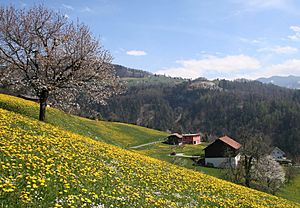
The dandelion is a common colonizer of disturbed habitats, both from wind blown seeds and seed germination from the seed bank. The seeds remain viable in the seed bank for many years, with one study showing germination after nine years. This species is a somewhat prolific seed producer, with 54 to 172 seeds produced per head, and a single plant can produce more than 5,000 seeds a year. It is estimated that more than 97,000,000 seeds/hectare could be produced yearly by a dense stand of dandelions. When released, the seeds can be spread by the wind up to several hundred meters from their source. The seeds are also a common contaminant in crop and forage seeds. The plants are adaptable to most soils and the seeds are not dependent on cold temperatures before they will germinate but they need to be within the top 2.5 cm (1 in) of soil.
T. officinale is food for the caterpillars of several Lepidoptera (butterflies and moths), such as the tortrix moth Celypha rufana. See also List of Lepidoptera that feed on dandelions.
Even though dandelion pollen is of poor nutritional quality for honey bees, they readily consume it, and it can be an important source of nutritional diversity in heavily managed monocultures such as that of blueberries. Honey bees have not been shown to lower their pollination activity on nearby fruit crops when foraging on dandelions.
While not in bloom, this species is sometimes confused with others, such as Chondrilla juncea, that have similar basal rosettes of foliage. Another plant, sometimes referred to as fall dandelion, is very similar to dandelion, but produces "yellow fields" later. Its blooms resemble some of the species of Sonchus, but are larger.
Uses
| Nutritional value per 100 g (3.5 oz) | |
|---|---|
| Energy | 188 kJ (45 kcal) |
|
9.2 g
|
|
| Sugars | 0.71 g |
| Dietary fiber | 3.5 g |
|
0.7 g
|
|
|
Protein
|
2.7 g
|
| Vitamins | Quantity
%DV†
|
| Vitamin A equiv.
beta-Carotene
lutein zeaxanthin
|
64%
508 μg
54%
5854 μg13610 μg
|
| Thiamine (B1) |
17%
0.19 mg |
| Riboflavin (B2) |
22%
0.26 mg |
| Niacin (B3) |
5%
0.806 mg |
| Pantothenic acid (B5) |
2%
0.084 mg |
| Vitamin B6 |
19%
0.251 mg |
| Folate (B9) |
7%
27 μg |
| Choline |
7%
35.3 mg |
| Vitamin C |
42%
35 mg |
| Vitamin E |
23%
3.44 mg |
| Vitamin K |
741%
778.4 μg |
| Minerals | Quantity
%DV†
|
| Calcium |
19%
187 mg |
| Iron |
24%
3.1 mg |
| Magnesium |
10%
36 mg |
| Manganese |
16%
0.342 mg |
| Phosphorus |
9%
66 mg |
| Potassium |
13%
397 mg |
| Sodium |
5%
76 mg |
| Zinc |
4%
0.41 mg |
| Other constituents | Quantity |
| Water | 85.6 g |
|
Link to USDA Database entry
|
|
| †Percentages estimated using US recommendations for adults. | |
The plant has several culinary uses: the flowers are used to make dandelion wine, the greens are used in salads, the roots have been used to make a coffee substitute (when baked and ground into powder) and the plant was used by Native Americans as a food and medicine.
Culinary
Dandelions are harvested from the wild or grown on a small scale as a leaf vegetable. The leaves (called dandelion greens) can be eaten cooked or raw in various forms, such as in soup or salad. They are probably closest in character to mustard greens. Usually the young leaves and unopened buds are eaten raw in salads, while older leaves are cooked. Raw leaves have a slightly bitter taste. Dandelion salad is often accompanied with hard-boiled eggs. The leaves are high in vitamins A and C, as well as iron, phosphorus, and potassium.
Dandelion flowers can be used to make dandelion wine, for which there are many recipes. Most of these are more accurately described as "dandelion-flavored wine," as some other sort of fermented juice or extract serves as the main ingredient. It has also been used in a saison ale called Pissenlit (the French word for dandelion, literally meaning "wet the bed") made by Brasserie Fantôme in Belgium. Dandelion and burdock is a soft drink that has long been popular in the United Kingdom.
Another recipe using the plant is dandelion flower jam. In Silesia and other parts of Poland and the world, dandelion flowers are used to make a honey substitute syrup with added lemon (so-called May-honey). Ground roasted dandelion root can be used as a non-caffeinated coffee substitute.
Diuretic
T. officinale's diuretic properties - believed to be a result of the plant’s high potassium content - have been well described, with the leaves of this plant having been used for this purpose in traditional Chinese medicine for approximately 2,000 years, with other regions of the world using the plant in the same way; in French, a common name for T. officinale is pissenlit, 'a colorful description of its diuretic activity.' A study conducted in 2009 noted 'promising' results regarding these diuretic properties, but that further studies would need to be conducted into the plant's efficacy.
Herbal medicine
Dandelion has been used in traditional medicine in Europe, North America, and China.
Other
Yellow dye colors can be obtained from the flowers but little color can be obtained from the roots of the plant. The latex can be used as a kind of glue.
See also
 In Spanish: Diente de león para niños
In Spanish: Diente de león para niños



